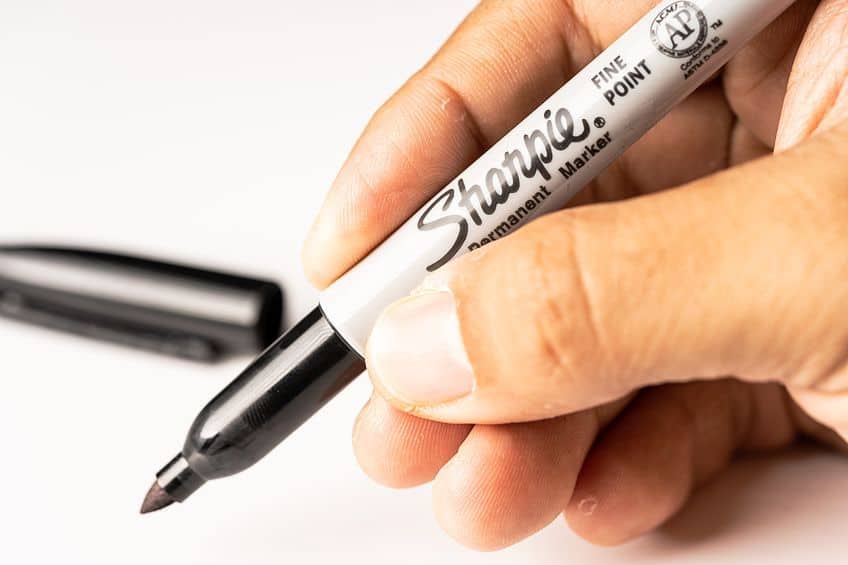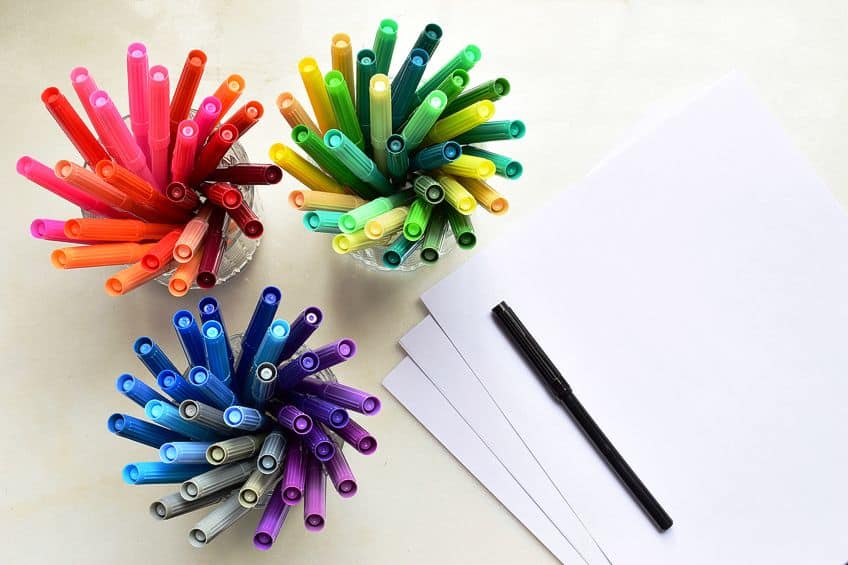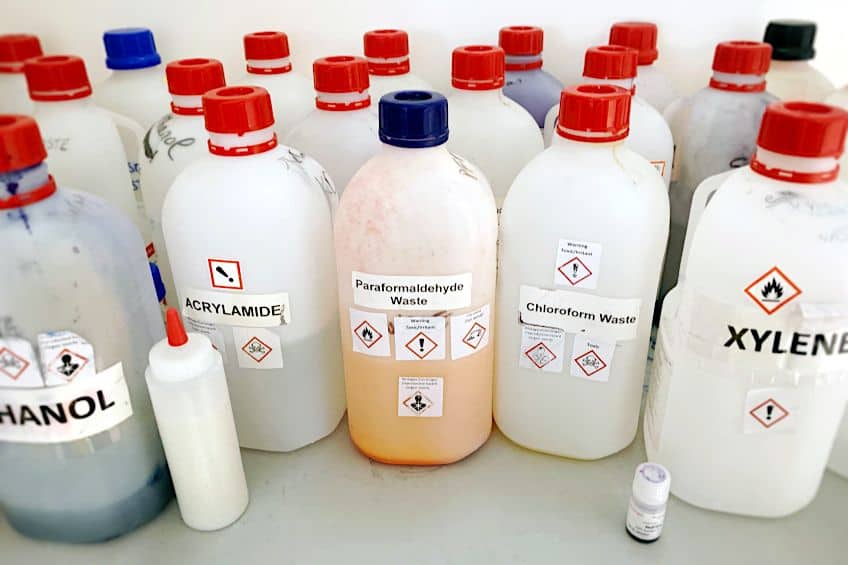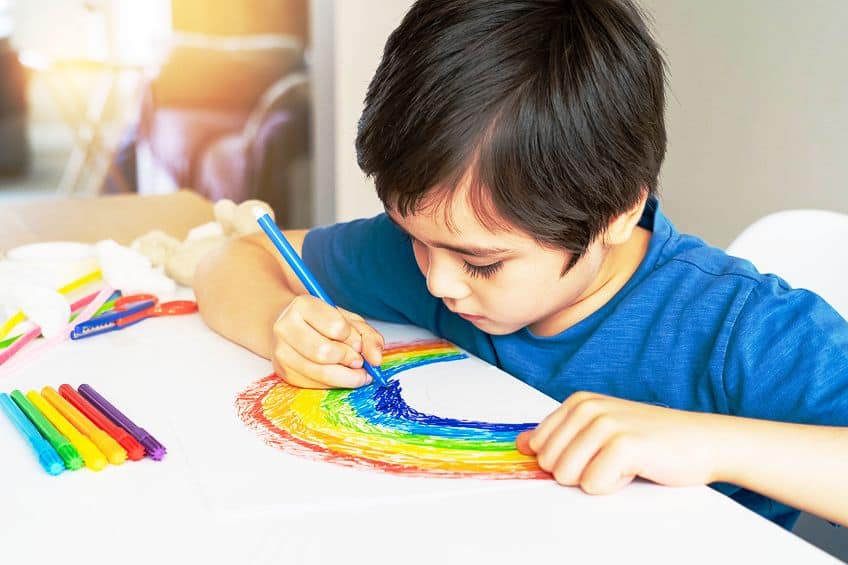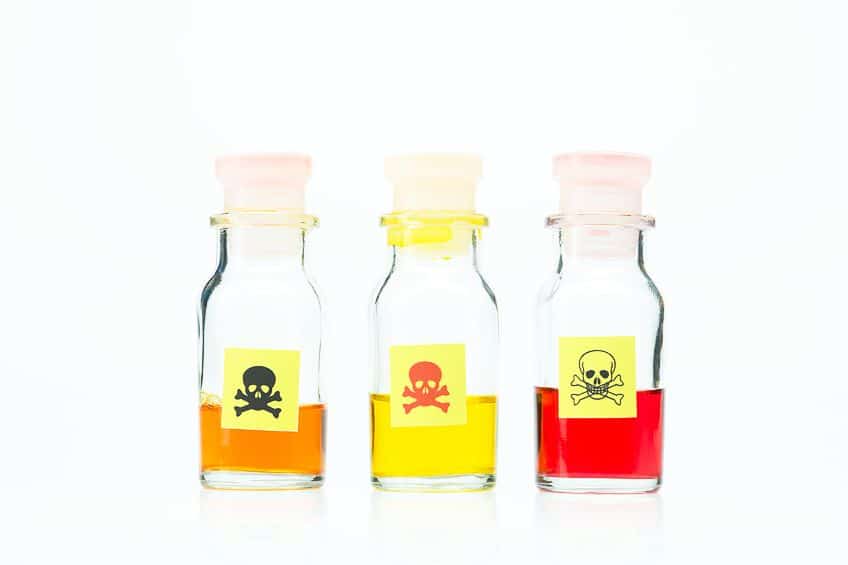Are Sharpies Toxic? – Tips for Using Sharpies
The wide variety of Sharpie markers available allows them to be used on a variety of surfaces, with some tattoo artists even using Sharpies on the skin to stencil on their designs. Because of this, you may be wondering, “are Sharpies toxic?”, and “if you can get ink poisoning from a Sharpie?”. In this article, we explore how safe Sharpie markers are to use, as well as any precautions you should take when using them.
Key Takeaways
- Sharpie markers are not recommended for extended or extensive use on skin, particularly broken skin.
- There are numerous Sharpies that are non-toxic, however, there are also those that contain toxic solvents such as xylene that have been known to cause many adverse effects, including organ damage.
- Xylene is a neurotoxin found in some Sharpies that can be inhaled, ingested, or absorbed through skin and mucous membranes.
- The safest marker to use on skin are colored Sharpie Fine Point Markers, however, caution should be taken to not use them on or near your eyes and lips.
- The Touch-Up, Magnum, and King Size Sharpie ranges all contain the neurotoxin xylene as a solvent.
- Rubbing alcohol can be used to remove Sharpie marker ink, however, if you are removing it from your skin, ethanol is better to use as it is less harsh.
- No Sharpie marker, and most permanent markers produced in Europe, America, and Australia, contain carcinogens, and are not a proven cause of cancer.
What Are Sharpies?
Sharpies are a brand of stationary established in the 1800s that specializes in permanent and semi-permanent markers. Since its inception, over 200 million Sharpie markers have been sold globally. Sharpies are very versatile and come in many different colors and finishes from your traditional black to neon to metallics.
Permanent markers are marker pens that contain ink or pigment suspended in a non-water-based medium.
This allows the pigment to adhere permanently or semi-permanently to a variety of surfaces and not be dissolved or washed away when exposed to moisture. Permanent markers are also known as indelible markers and many people refer to all marker pens as “Sharpies” today even if they are not produced by the company.
What Are Sharpies Made From?
Sharpie pens generally contain different alcohol solvents such as diacetone alcohol, n-propanol, n-butanol, and cresol. Both diacetone alcohol and n-propanol are relatively safe, with n-propanol being considered safe enough for use in cosmetics. N-butanol does come with a risk of toxicity, however, this is a very low risk as there is only a small amount of the solvent used in the pen. Although the toxicity is low, n-butanol is still highly irritating to the eyes.
Cresol is also very irritating to the eyes and is known to cause organ problems when ingested in large amounts.
The black ink in permanent Sharpie markers primarily use alcohol solvents; however, some also contain ethylene glycol monobutyl ether, which makes it dry quicker. Glycol ethers can cause many adverse effects when they are inhaled or absorbed through the skin, including dizziness, headaches, nausea, and vomiting.
They can also cause diarrhea and vomiting if it is ingested. All other colors of Sharpie markers contain a special ink called Permachrome ink. These Sharpies also primarily use alcohol solvents but do not contain any glycol ethers, making them safer to use on your skin than the black ink varieties.
There are a few heavy-duty Sharpies that use xylene as a solvent.
Xylene has been linked to damage to the cardiovascular, respiratory, and central nervous systems when exposed to it over a long time. Xylene gives markers their strong odor, causes weakness and nausea when inhaled, and irritates the skin. Markers that do not use xylene make use of a solvent substitute. This substitute is known as a Non-Hazardous Air Pollutant and is usually an alcohol such as ethanol or isopropanol, which are much safer.
Different Types of Sharpies
Sharpie produces an array of markers in 49 unique colors all with different tip sizes and effects, which make them handy for a variety of uses. Calligraphy and line art are popular art techniques to do with markers and many artists make use of markers alongside other mediums such as watercolor paints or colored pencils. This versatility is only possible because of the wide range of different types of Sharpies available.
Different pen types have different formulations which can be more or less toxic depending on the ingredients used.
Highly Toxic Sharpies
Three types of Sharpie markers contain xylene, namely the Magnum, King Size, and Furniture Touch-Up Sharpies. These are industry-grade pens and are not intended for use on the skin. Even inhaling a lot of the vapor released by these Sharpies or ingesting them can cause many adverse effects and even injury.
Semi-Toxic Sharpies
The black variations of Twin Tip, Chisel, Retractable, Mini, Super, Fine, and Ultra-Fine markers are permanent ink markers. These pens primarily use alcohol solvents; however, they also contain ethylene glycol monobutyl ether. These Sharpies can be used on the skin but not in large amounts or over an extensive period of time.
Caution should also be taken to not use these markers near the face, particularly around the eyes and mouth.
Non-Toxic Sharpies
Non-toxic Sharpies are those that will not have any harmful effects on your skin, provided that it is not used on damaged skin or an open wound. Any foreign substance that enters the bloodstream through compromised skin can have adverse effects so be sure to avoid using Sharpies in these areas. Sharpie’s Fine Point Markers are considered safe markers when not inhaled, ingested, or used extensively on the skin and face. The colored range of these markers is even safer to use on the skin as they use a relatively harmless solvent and do not contain any glycol ethers.
Markers that have the ACMI “non-toxic” seal have undergone toxicological testing by the Arts and Creative Materials Institute and are safe for use by children. Even so, it is not recommended that you use it on your skin, particularly near your eyes and mouth. This is because the seal only ensures that the product is not toxic when inhaled or ingested, but does not test for the effects if it is absorbed into the bloodstream, which could occur if the Sharpie is absorbed through the skin.
Skin-Safe Markers
While some people, such as tattoo artists, may use Sharpies, some markers are guaranteed to be safe to use on skin. Skin-safe markers are specially formulated for use on skin. These markers are not only gentler on your skin but can also be removed easily without the need for harsh products. If you are planning on giving yourself a tattoo, or drawing on your skin very often, then these are a better option for your skin.
Examples of these markers include the BodyMark Temporary Tattoos from BIC or the Face Paint line from Jim & Gloria.
Ink Poisoning and Sharpies
When considering if Sharpies are toxic, many may worry about the risk of developing ink poisoning, particularly when using them on your skin. You can experience ink poisoning when you have been exposed to large amounts of ink made from poisonous ingredients, either through ingestion or absorption of these toxic compounds through the skin.
If you have been chewing a pen that accidentally breaks or your friend has pranked you by drawing with markers on your skin, you do not need to be overly concerned about getting ink poisoning.
When asking whether you can get ink poisoning from a Sharpie it is important to note that there is very little ink contained in these pens. Even ingesting two or three Sharpies will not put you at risk of any serious ink poisoning, although there might be some staining and irritation to the lining of your mouth along with mild indigestion. As you can see solvents are the most dangerous aspects of Sharpies rather than the ink itself.
Once the ink has dried, however, the solvent no longer poses a risk and so the ink becomes largely safe even if on the skin. Adverse reactions to the ink pigments are also not very common so all this makes Sharpies relatively safe.
That being said, Sharpies that use Xylene, toluene, or benzene as solvents are still toxic to breathe if you breathe in their fumes.
Markers that do not make use of Xylene or these other types of benzenes are generally safe to use, even on your skin. The easiest way to see if they contain these compounds is to read the ingredients listed on the label of the marker. Experiencing adverse effects from these solvents are not technically considered ink poisoning as the source of the toxicity is the solvent and not the ink itself.
Is Sharpie Bad for Your Skin?
You might be wondering, is it bad to draw on yourself with Sharpie? When used in moderation is fine but like with anything, overdoing it may cause some unforeseen consequences. Extended and extensive use of Sharpies on your skin may cause irritation, redness, and rashes as it inhibits your skin’s ability to breathe.
We have covered some ingredients that are used in Sharpies that may irritate the skin, however, it is not just the marker that will irritate your skin but the process of removing the ink as well.
If you have gotten Sharpie on your skin, even from markers that use xylene, you will likely not experience any lasting effects. At worst you might develop a skin irritation or rash if you have sensitive or damaged skin. The pigment of permanent markers only penetrates the uppermost layers of the skin, and the pen ink will fade gradually from your skin over a few days depending on how often you wash the area.
Sharpie and Skin Cancer
There are many myths about developing skin cancer from using ink on your skin, but this is largely false. The vast majority of Sharpies sold today do not contain carcinogenic ingredients and the official Sharpies manufactured in the USA, Europe, Canada, and Australia are guaranteed to be free of them.
Even if you were to cover your whole body in Sharpie marker, it will not cause skin cancer since it does not penetrate deep enough to modify your skin cells.
Removing Sharpie from Your Skin
If you wish to remove the ink earlier, however, the non-water-based medium in permanent marker means that it will not come off with soap and water alone. There are many methods of removing markers from the skin, each with its own advantages and disadvantages.
Mineral Oil
Applying mineral oil to fresh Sharpie marks will loosen the molecules of the ink and make it much easier to remove. You can then wash away the permanent marker with soap and warm water after applying the oil. This method works particularly well on colored markers and ink that has been newly applied to the skin so is the best option for immediately removing any stray ink you may have gotten on your hands while working on your art.
Unfortunately, the older the mark is, the least effective this method will be at removing it.
Alcohol Based Cleaner
Another popular method of removing Sharpie from the skin is by using alcohol to dissolve the pigment. This method can be much harsher on the skin depending on the type of alcohol you use. Opt for gentler alcohols such as those found in hand sanitizer and mild rubbing alcohols made from 40% ethyl solution. Nail polish remover can also be used in a pinch.
This method is particularly effective at removing ink that has been on your skin for prolonged periods, however, it can cause mild skin irritation or a rash, especially if used often or in very large amounts.
These types of cleaners can also cause severe irritation to the skin on your face and particularly around your eyes so avoid using them in these areas unless absolutely necessary. If you are planning on creating a fun Sharpie tattoo that you plan on removing later it is a good idea to test a small, unseen patch of your skin first. This way you can see if your skin will have an adverse reaction to the marker as well as test how well it can be removed before covering a large section.
Sharpie markers, like most other permanent markers, are generally safe to use as they only contain small amounts of potentially toxic ingredients. Even the markers that use Xylene as a solvent are safe to use when used as directed. You should always follow the cautions and guidelines that come with your permanent markers to avoid any unwanted consequences. If you are planning on using a Sharpie marker to create your next temporary tattoo, consider using specialized skin-safe markers to achieve the best results in the safest way.
Frequently Asked Questions
What Are Sharpies?
Sharpie is a stationery brand that was established in 1857, that specializes in permanent markers. Although they started with only a single type of marker, they now come in a wide variety of tip sizes, colors, and finishes. Permanent markers are also known as indelible markers and contain pigments mixed in a non-water-based medium, which enables them to adhere permanently or semi-permanently to multiple surfaces. Today, most marker pens are referred to as Sharpies, even if they are not made by the company.
Is Sharpie Bad for Your Skin?
While many Sharpies are non-toxic, they do contain a few ingredients that can be irritating to your skin. Although adverse reactions to the ink itself are rare, the solvents used in permanent markers can cause irritation and rashes if used very often in the same place. Frequently using Sharpie on your skin, or covering large areas, impacts your skin’s ability to breathe and can result in redness and irritation. Even if Sharpie pens are considered safe for skin, it is bad to draw on yourself with Sharpies around your lips and eyes, as the skin is much more sensitive and prone to irritation in these areas. Most importantly, using Sharpie markers on your skin will not cause you to develop skin cancer or result in ink poisoning.
Can You Get Ink Poisoning from a Sharpie?
No, you cannot get ink poisoning from a Sharpie marker, whether it is ingested or drawn on the skin. Sharpie markers contain too little ink to pose a risk of ink poisoning, but ingesting excessive amounts of it can lead to staining and irritation of the mouth and throat, as well as mild diarrhea. The solvents used in Sharpie markers pose more of a risk than the ink itself; however, these are also only present in small amounts, and developing adverse effects from them is not considered ink poisoning.
Megan is a writer and researcher who holds a degree in Social Sciences, with a specialization in Psychology and Environmental Science, from the University of Cape Town. Her dedication to acquiring knowledge and making a positive impact has driven her current work in promoting conscious and sustainable growth in Southern Africa. Megan’s interests encompass exploring the physical and psychological impacts of color in our environment on our mood and well-being. She is also passionate about the role of art and creativity, which has been an integral part of society since the beginning of human history. Since 2022, Megan has been contributing blog posts on painting and color theory at artfilemagazine.
Learn more about Megan van Schoor and about us.
Cite this Article
Megan, van Schoor, “Are Sharpies Toxic? – Tips for Using Sharpies.” artfilemagazine – Your Online Art Source. March 28, 2023. URL: https://artfilemagazine.com/are-sharpies-toxic/
van Schoor, M. (2023, 28 March). Are Sharpies Toxic? – Tips for Using Sharpies. artfilemagazine – Your Online Art Source. https://artfilemagazine.com/are-sharpies-toxic/
van Schoor, Megan. “Are Sharpies Toxic? – Tips for Using Sharpies.” artfilemagazine – Your Online Art Source, March 28, 2023. https://artfilemagazine.com/are-sharpies-toxic/.



